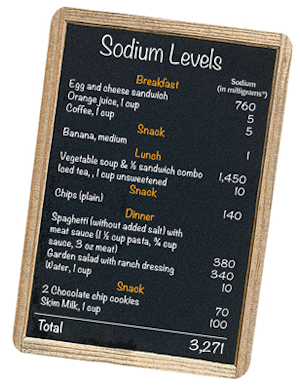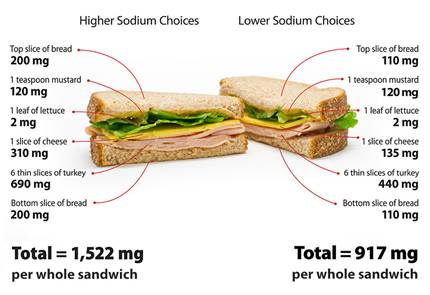Sodium Reduction
Check the sodium on food labels. Choosing less is best.
Why should you care about sodium?
Reducing sodium is an important goal for good health. Eating too much sodium, which is the primary ingredient in salt, can raise your blood pressure, as well as your risk of heart attack and stroke. If you already have high blood pressure, a high-sodium diet is dangerous.
Even people who do not have high blood pressure could benefit from a lower-sodium diet.
Most of us should eat no more than 2,300 mg of sodium per day. That is the same amount found in about 1 teaspoon of salt. For people with high blood pressure, the recommended amount is just 1,500 mg per day. Most Americans eat much more than what is recommended – about 3,400 mg per day, on average.
Where does most of the sodium in our diets come from?
For most of us, the saltshaker is not the greatest source of sodium in our diets. Sodium can add up quickly throughout the day when we eat packaged, processed, store-bought and restaurant foods that have many added ingredients to keep them from going bad or losing their flavor. More than 75% of our sodium comes from processed food.
Some foods that add the most sodium to our diets:
- Breads
- Cold cuts
- Pizza
- Canned soups
- Snack foods
Choosing high-sodium foods throughout the day can add up to more than the recommended amount of sodium.

*Image from CDC
| Breakfast | |
|---|---|
| Egg and cheese sandwich | 760 |
| Orange juice, 1 cup | 5 |
| Coffee, 1 cup | 5 |
| Snack | |
| Banana, medium | 1 |
| Lunch | |
| Vegetable soup, 1/2 sandwich combo | 1,450 |
| Iced tea, 1 cup unsweetened | 10 |
| Snack | |
| Chips, (plain) | 140 |
| Dinner | |
| Spaghetti (without added salt) with meat sauce (1 1/2 cup pasta, 3/4 cup sauce, 3 oz meat) | 380 |
| Garden salad with ranch dressing | 340 |
| Water, 1 cup | 10 |
| Snack | |
| 2 Chocolate chip cookies | 70 |
| Skim milk, 1 cup | 100 |
| Total | 3,271 |
Because sodium is added to many foods, the best way to reduce sodium is to choose healthier foods.
Small changes can make a big difference.

*Image from CDC
| Ingredient | Higher-Sodium Choices (mg) | Lower-Sodium Choices (mg) |
|---|---|---|
| Top slice of bread | 200 | 110 |
| 1 teaspoon mustard | 120 | 120 |
| 1 leaf lettuce | 2 | 2 |
| 1 slice cheese | 310 | 135 |
| 6 thin slices of turkey | 690 | 440 |
| Bottom slice of bread | 200 | 110 |
| Total per whole sandwich | 1,522 | 917 |
Feel and be healthier. Cutting out extra sodium could help.
- Read nutrition labels and choose foods with less sodium; choosing less is best.
- Cook from scratch using fresh lean meats, poultry, and fish instead of canned or processed meats. Avoid buying packaged or highly processed food.
- Enhance your food's flavor with spices, seasonings, herbs, lemon juice, onions, or garlic. Avoid seasonings with "salt" in their name, such as "garlic salt" or "celery salt."
- Eat more fresh foods, such as fruits and vegetables. When using canned beans and vegetables, rinse them first to remove extra sodium.
- Limit high-sodium foods, such as restaurant foods, fast foods, convenience products, condiments and sauces.
- Ask for low-sodium options any time you or your family eat outside your home. This will increase demand, making these foods more available. Ask for healthier items from your grocer, college, childcare center, school, and retirement facility.
- Ask your registered dietitian about low-sodium foods and tips to reduce sodium. If you do not have a registered dietitian, ask your doctor for a referral.
| Meats, Fish, Poultry, Legumes, Eggs and Nuts | |
|---|---|
| Lower-Sodium Choices | Higher-Sodium Choices |
| Fresh or frozen pork, beef, or lamb | Cold cuts, salted or canned meats, bacon, corned beef, hot dogs, ham, and sausages |
| Fresh or low-sodium canned fish or poultry, packed in water or oil, drained | Regular canned or salted fish, such as sardines and anchovies |
| Home-cooked meals using fresh ingredients | Frozen dinners such as pizza or burritos; canned entrees, such as ravioli and chili; and breaded meats, such as chicken nuggets |
| No–salt-added nuts, low-sodium peanut butter | Salted nuts and seeds |
| Dried beans and peas, low-sodium canned beans (if using regular canned beans rinse with water to remove some sodium) | Canned beans with added salt or bacon |
| Soups | |
| Lower-Sodium Choices | Higher-Sodium Choices |
| Low-sodium canned soups, broth, and bouillon | Regular canned soups, broth, and bouillon |
| Homemade soups without added salt | Dehydrated soups and instant soup mixes |
| Breads, Cereals, and Grains | |
| Lower-Sodium Choices | Higher-Sodium Choices |
| Plain pasta, rice, quinoa, and barley. Do not salt water when cooking. | Prepackaged, processed mixes for rice, pasta, and stuffing, such as boxed macaroni and cheese |
| Low-sodium breads, old-fashioned oats, and most ready-to-eat cereals | Quick breads, instant cooked cereals, biscuits, waffle, and pancake mixes |
| Low-sodium crackers and tortillas | Salted crackers and seasoned croutons |
| Unsalted popcorn, or low-sodium pretzels and chips | Salted microwave popcorn, regular pretzels, and chips |
| Condiments, Fats and Sweets | |
| Lower-Sodium Choices | Higher-Sodium Choices |
| Vegetable oils and low-sodium sauces and salad dressing (or homemade, prepared without salt), vinegar, lemon juice | Regular salad dressings, marinades, soy sauce, teriyaki and other sauces, canned or instant gravy |
| Salt-free seasonings, herbs, and spices | Seasoning salts, bacon bits |
| Vegetable oils, unsalted butter, or margarine | Salted butter and margarine |
| Mayonnaise | Large servings of ketchup and mustard |
| Desserts made without salt, Italian ice, sorbet | Instant puddings, Danish, doughnuts, baking mixes |
| Dairy | |
| Lower-Sodium Choices | Higher-Sodium Choices |
| Milk, soy milk, yogurt, ice cream | Buttermilk |
| Low-sodium or reduced-sodium cheeses, naturally low-sodium cheeses (cream cheese, fresh mozzarella, ricotta, Swiss, and goat) | Regular and processed cheeses (American, cheddar, cottage cheese, cheese spreads or sauces) |
| Vegetables and Fruits | |
| Lower-Sodium Choices | Higher-Sodium Choices |
| Low-sodium canned vegetables, low-sodium vegetable juices, and low-sodium tomato juices | Regular canned or marinated vegetables, regular vegetable juices, and regular tomato juice |
| Homemade salsa or fruit chutney | Pickled vegetables, olives, or sauerkraut |
| Frozen vegetables and potatoes without added butter or sauce | Packaged or frozen vegetables in sauce, packaged or frozen potato mixes, such as potatoes au gratin and scalloped potatoes |
| Homemade marinara, crushed tomatoes, low-sodium or no-salt-added tomato sauces | Commercially prepared, jarred, or canned pasta and tomato sauces |
| Most fresh, frozen, dried, and canned fruit | N/A |
- Learn more about sodium by visiting the CDC website: Salt
- For high blood pressure information, please visit: Heart Disease Risk Factors